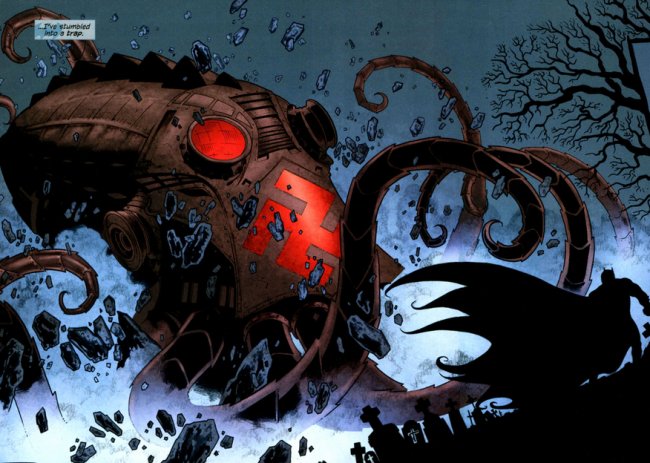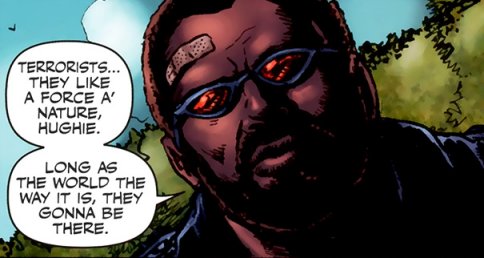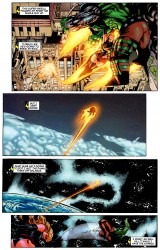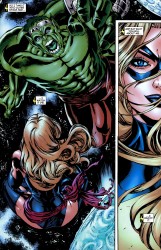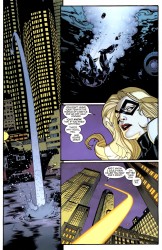
They Got More Rights Than Miranda
November 9th, 2009 Posted by david brothersBrandon Thomas, creator of Miranda Mercury, has jumped from Newsarama and launched a new blog to hold his thoughts and long-running Ambidextrous column. Ambi 316 went live this morning, and it’s a clearing of the deck/status report for Miranda. Definitely worth reading.
I wrote a review of the first issue for another site back when it first came out, but it’s apparently been lost to the wilds of site redesigns and Google page ranks. Lucky for you, I’ve reproduced it below. Go show Brandon some love, pick up his comic when it comes out again, and let’s get this book turned from a Thing into an Avalanche. It’s a little bit Kirby, a little bit Star Wars, a little bit Indiana Jones, and a lot of day-glo adventure comics. It’s fun in a way that doesn’t need modifiers.
You can see a preview of #295 here, and the sadly unreleased #296 here. Remember that the front cover is the first page of the comic.
(I love the idea of the radial pulse cannon.)
The Many Adventures of Miranda Mercury
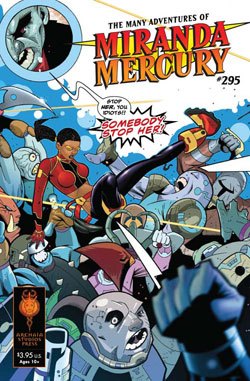 Let me list three of my top five favorite creators: Frank Miller, Jim Lee, and Brian Azzarello. All three of them dropped books this past week, and yet my book of the week was produced by Brandon Thomas and Lee Ferguson?
Let me list three of my top five favorite creators: Frank Miller, Jim Lee, and Brian Azzarello. All three of them dropped books this past week, and yet my book of the week was produced by Brandon Thomas and Lee Ferguson?
Let me introduce you to The Many Adventures of Miranda Mercury #295. No, you didn’t miss 294 issues of a comic somehow- Miranda Mercury‘s conceit is that there is a storied past behind the title character and that this is just the latest of her adventures. Miranda is a hero in the Doc Savage, Tom Strong, Flash Gordon, Buck Rogers mold. She’s out to have a good time, see the sights, and maybe even learn a little bit while she’s out and about.
The book first caught my eye because it stars a black female. If you’ve been reading 4l!, you know that I feel pretty strongly about the lack of positive black females in comics. Lee Ferguson’s art delivered up a black girl who is both cool and attractive without being sexed up. Thomas’s script brought it all home when it put Miranda’s quick wit and stubborn will on display.
Basically, this comic is great. The cover page ties into the story in a big way (here’s a hint: it’s the first page of the story), the art is insanely attractive, and the story is a great one. Despite being dropped in mid-scene, it’s very easy to follow. You have the villain, the heroine, the sidekick, the hook, and the twist. The villain is a short fellow with an anger problem. The heroine is a skilled fighter in that Indiana Jones kind of way. The sidekick is a supersmart kid with a penchant for possibly being too smart for his own good. The hook is a magical cube that lets you have one wish once you solve its puzzle. The twist? The twist is something I won’t ruin, but which casts the series in a new light.
This isn’t Brandon Thomas’s first comic. He wrote an issue of Robin a few months back, just pre-Resurrection of Ra’s al Ghul, that was the best single issue that book had seen in probably eight years. It was just a quick done-in-one about Robin, and ended on a few pages that really nailed the Batman/Robin dynamic for me.
Thomas displayed a deft grasp of the characters and dialogue in that book, and it’s carried over to Miranda Mercury. You get a feeling of real history between all the characters, but not the kind of history that feels manufactured. There’s none of the “Like that time on Alphozon-VII, where you narrowly escaped my clutches!”-style awful exposition. Just quick lines that hint at a shared past and allow your imagination to fill in the blanks.
The Many Adventures of Miranda Mercury #295 is, as far as I’m concerned, an incredible success. The characters and art are equally vibrant, the story has a great twist at the end without being an annoying cliffhanger, and I’m genuinely interested in where the story is going to go. Miranda Mercury is an A+ right off the starting block.

